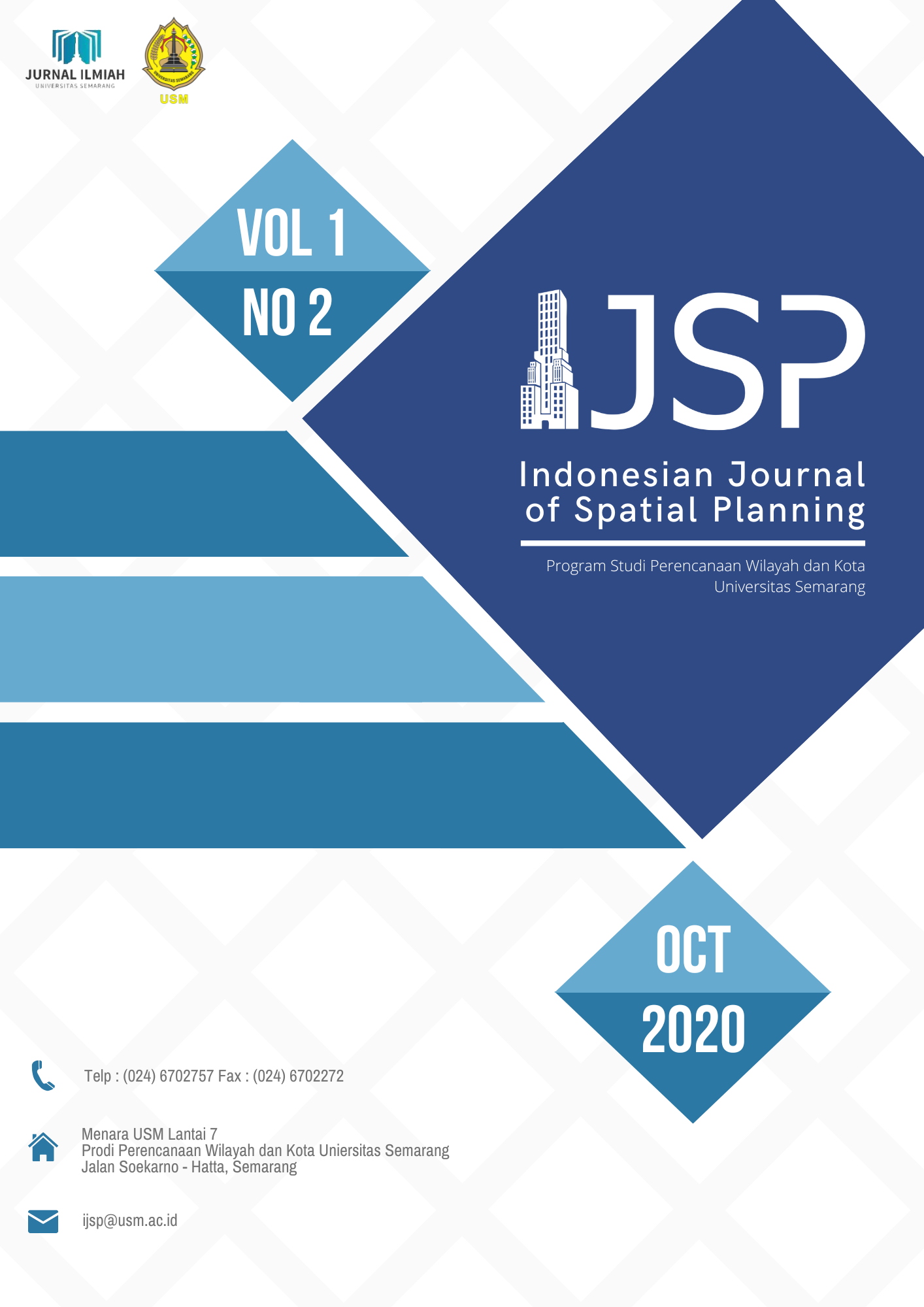POTENSI REDUKSI LIMPASAN PERMUKAAN DENGAN METODE SOIL CONSERVATION SERVICE - CURVE NUMBER DI KELURAHAN RAWA BUNTU
DOI:
https://doi.org/10.26623/ijsp.v1i2.3107Keywords:
Green Space, Rainwater Runoff, SCS-CN, Rawa Buntu Subdistrict, Land CoverAbstract
Development in Rawa Buntu Subdistrict caused land use change and made green space area in Rawa Buntu Subdistrict decreased, so it could cause flood. This research was conducted to know the potential of rainwater runoff reduction in each type of land cover in Rawa Buntu Subdistrict to serve as the basis for better planning in the future. The Soil Conservation Service - Curve Number (SCS-CN) method is used to calculate the total rainfall runoff that can be reduced and to know the role of green space in reducing rainwater runoff. The result of the research shows that residential area dominates Rawa Buntu Subdistrict about 65% and green space is only about 18%. The volume of rainfall runoff that can be reduced each month on AMC I, AMC II and AMC III is 74,4MGal, 37,8MGal and 17,9MGal with green space contribution of 27%, 31,2% and 36,4% of the total rainfall runoff that can be reduced for each AMC condition.References
Amin, M. Baitullah Al. 2016. Analisis Genangan Banjir di Kawasan Sekitar Kolam Retensi dan Rencana Pengendaliannya, Studi Kasus: Kolam Retensi Siti Khadijah Palembang. Jurnal Perencanaan Wilayah dan Kota, 27 (2), 69-90.
Andini, Febby Ekamukti, Yulisa Fitrianingsih, dan Agus Ruliyansyah. 2016. Evaluasi Fungsi Ekologis Ruang Terbuka Hijau (RTH) Perkotaan Sebagai Areal Resapan di Kota Pontianak (Studi Kasus: Taman Alun Kapuas). Jurnal Mahasiswa Teknik Lingkungan UNTAN, 1 (1), 1-10.
Arsyad, Sitanala dan Ernan Rustiadi. 2012. Penyelamatan Tanah, Air, dan Lingkungan. Jakarta: Crestpent Press dan Yayasan Pustaka Obor Indonesia.
Asdak, Chay. 2010. Hidrologi dan Pengelolaan Daerah Aliran Air Sungai: Edisi Revisi Kelima. Yogyakarta: Gadjah Mada University Press Yogyakarta.
Badan Pusat Statistik. 2006-2017. Jakarta dalam Angka 2006-2017. Jakarta: Badan Pusat Statistik Provinsi DKI Jakarta.
Butler, David, dan Davies, John W. 2011. Urban Drainage 3rd Edition. New York: Spon Press.
Chow, V.T. 1964. Handbook of Applied Hydrology: a Compendium of Water- Resources Technology. New York: McGraw-Hill Companies.
Chow, V.T. 1964. Handbook of Applied Hydrology: a Compendium of Water- Resources Technology. New York: McGraw-Hill Companies.
Day, C. Andrew dan Keith Allen Bremer. 2013. Modeling Urban Hydrology: A Comparison of New Urbanist and Traditional Neighborhood Design Surface Runoff. International Journal of Geosciences, 4 (5), 891-897.
El-Hames, A. S. 2012. An empirical method for peak discharge prediction inungauged arid and semi-arid region catchments based on morphological param-eters and SCS curve number. Journal of Hydrology, 456-457, 94 100.
Khaqim, Luqman dan Kwardiniya A. 2013. Proyeksi Penduduk Provinsi DKI Jakarta dan Kota Surabaya dengan Model Pertumbuhan Logistik. Jurnal Mahasiswa Matematika, 1 (3), 232-235.
Palar, Ronaldo Toar, dkk. 2013. Studi Perbandingan Antara Hidograf SCS (Soil Conservation Service) dan Metode Rasional Pada DAS Tikala. Jurnal Sipil Statik, 1 (3), 171-176.
Ponce, Victor Miguel. 1989. Engineering Hidrology: Principles and Practices. New Jersey: Prentice Hall.
Undang-Undang Republik Indonesia. 2007. Penataan Ruang (nomor 26 Tahun 2007). Jakarta: Presiden Republik Indonesia.
Zhang, B., dkk. 2015. Effect of urban green space changes on the role of rainwater runoff reduction in Beijing, China. Landscape and Urban Planning, 140, 8 16.
Downloads
Published
Issue
Section
License
Authors who publish with this journal agree to the following terms:
Authors retain copyright and grant the journal right of first publication with the work simultaneously licensed under a Creative Commons Attribution 4.0 International License that allows others to share the work with an acknowledgement of the work's authorship and initial publication in this journal.Authors are able to enter into separate, additional contractual arrangements for the non-exclusive distribution of the journal's published version of the work (e.g., post it to an institutional repository or publish it in a book), with an acknowledgement of its initial publication in this journal.
Authors are permitted and encouraged to post their work online (e.g., in institutional repositories or on their website) prior to and during the submission process, as it can lead to productive exchanges, as well as earlier and greater citation of published work (See The Effect of Open Access).

This work is licensed under a Creative Commons Attribution 4.0 International License.

